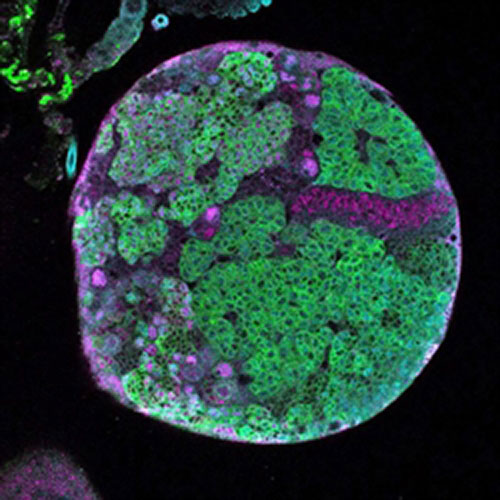![With the enzyme Eyeless knocked out, cells over-proliferate (shown in green) in a fruit fly's larval brain during reactivated Notch signaling. [University of Oregon]](https://genengnews.com/wp-content/uploads/2018/08/Dec8_2015_UnivOregon_CellsOverProliferate2091059882-1.jpg)
With the enzyme Eyeless knocked out, cells over-proliferate (shown in green) in a fruit fly’s larval brain during reactivated Notch signaling. [University of Oregon]
Investigators at the University of Oregon (UO) have recently uncovered molecular events experienced by stem cells as they age, which could provide new avenues toward the discovery of novel therapies for cancer and neurological disorders. The researchers noticed that these changes arise in Drosophila during the development of the central nervous and at that time a specific protein is expressed, blocking tumor formation.
The UO researchers were focused on the larval stage of fruit fly development, as this is when stem cells generate most of the neurons that form the adult's brain. During this process the stem cells are rapidly dividing in order to populate the central nervous system of the fly, and they rely heavily on the Notch signaling pathway—a developmentally important signal transduction pathway that has also been linked to cancer.
In previous studies, scientists have described scenarios where Notch signaling ran efficiently and stem cells produce neurons that populate the adult central nervous system. However, with too much Notch, stem cells lose control and over-proliferate—forming large tumors. In humans, adult T-cell leukemia is tied to overactive Notch signaling.
“Stem cells have a really tough job because they have to divide to make the millions of neurons in our brain,” explained Howard Hughes Medical Institute Investigator and senior author Chris Doe, Ph.D., professor of biology at the UO. “If they don't divide enough, it results in microcephaly or other small brain diseases, but if they divide too much, they make tumors. They have to stay right on that boundary of dividing to make neurons but not dividing excessively and forming a tumor. It's really walking a tightrope.”
The findings from this study were published recently in Current Biology through an article entitled “Aging Neural Progenitors Lose Competence to Respond to Mitogenic Notch Signaling.”
In the current study, the scientists discovered that if they waited for stem cells to divide a few times and age a bit, they quit responding to Notch. Moreover, the stem cells could not be pushed by high doses of Notch signaling to form tumors.
As the UO researchers looked closer, they uncovered a host of age-related molecular changes. As the stem cells get older and around the same time they begin to resist tumor formation, the stem cells begin expressing a transcription factor protein, known as Eyeless in Drosophila and Pax6 in humans. Its presence blocks Notch signaling.
Dr. Doe and his team described the genetic knockout of Eyeless in these stem cells, which led Notch signaling to overwhelm the precise growth balance and form tumors within the fruit flies.
“If we can identify the stem cells that are relied upon during development, maybe we could find a way to use them later to recreate conditions that might be therapeutic,” noted Dylan Farnsworth, a doctoral candidate at the UO. “If you do it incorrectly, you risk over-proliferation and the development of masses—and cancer.”
“This paper shows that Eyeless is important for winding down the lifespan of the stem cells that are giving rise to the adult brain,” Dr. Doe added. “It's a stop signal that says it is time to cease responding to Notch signals.”
The UO researchers were excited by their findings and believe that with more extensive research, their system could provide a roadmap for fine-tuning the timing of stem cell-based therapies to restart healthy activity in adult stem cells.


